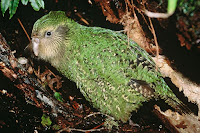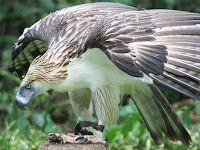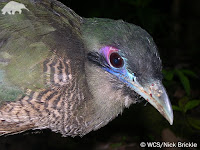
Giant Ibis
"This ibis has an extremely small population, which has undergone an extremely rapid decline as a result of hunting, disturbance and lowland deforestation. It is likely to continue to decline extremely rapidly, owing to on-going deforestation and human disturbance. It therefore qualifies as Critically Endangered."

Kakapo
"The kakapo has been extirpated throughout most of its range due to habitat destruction and predation. Its slow reproduction rate and elaborate mating system, which probably served as a useful natural population control when there were no predators, have only sped its demise."
 Kagu
Kagu"Sadly, following predation by dogs and habitat loss the Kagu is now listed as Endangered. The Kagu experienced a decline in numbers during the 1900s primarily due to predation by invasive species. Domestic dogs have historically been the main threat to the species along with cats and pigs."

Forest Owlet
"Unlike most of its nocturnal relatives, this owlet is diurnal, hunting lizards, birds and rodents in daylight hours. Whilst surveys continue to discover more individuals, habitat fragmentation caused by the continued loss of deciduous forest is likely to result in a further decline in this species."
 Philippine Eagle
Philippine Eagle"Among the rarest and most powerful birds in the world, it has been declared the Philippine national bird. It is critically endangered, mainly due to massive loss of habitat due to deforestation in most of its range. Killing a Philippine eagle is punishable under Philippine law by 12 years in jail and heavy fines."
 Sumatran Ground Cuckoo
Sumatran Ground Cuckoo"Whilst little is known about the species it may well be in decline due, primarily, to deforestation. There are currently a number of protected sites within the Barisan Mountains some of which overlap with the range of the Sumatran Ground-cuckoo"

No comments:
Post a Comment